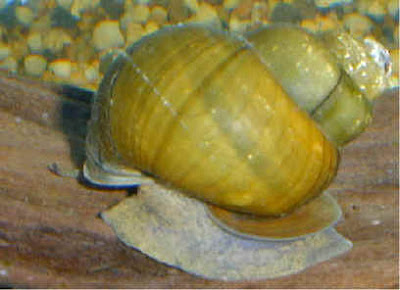The Best Algae Eater Snails for Tropical Tanks: Japanese Trapdoor Snail
The Best
Algae Eater Snails for Tropical Tanks: Japanese Trapdoor Snail – Here is the only snail's scientific name
about which I 'm 100% confident! Trapdoors are large (1-2 inch, normally about
1.25") snails formed like a swirly ball. While trapdoor snails don't
require dirt in the bottom of the pond to overwinter, they appreciate having a
few scattered leaves or a pot of dirt topped with pea gravel to "drive
around in." They do in older ponds with increased food.
 |
Photo copyright from aqualandpetsplus.com
|
The Best Algae Eater Snails for Tropical Tanks: Japanese Trapdoor Snail
This snail is a terrific
asset in keeping algae as they dress your plants, planting pots and watergarden
walls. They consume decaying matter such as fish food and leaves and also
cruise the pond bottom. They only breed a couple of times annually so don't
expect them to multiply fast like routine egg laying snails.
The Japanese Trapdoor
Snail originates from ponds and slow moving streams with some plant life and
also a muddy substrate. It's also called the Chinese Mystery Snail and is a
live bearing species. The shells of Japanese Trapdoor Snails can vary
significantly in pattern and color, but are generally brown/grey coloration.
Japanese Trapdoor Snail Attention
One of the best things
about Japanese Trapdoor Snail care is that its comparatively straightforward.
However there certainly are a couple things to bear in mind. Since Japanese
Trapdoor Snails don’t possess a siphon like Gold Inca Snails, they do not visit
the water surface to take in atmosphere. Still, the tank needs to be covered to
the extent possible. Trapdoor Snails become injured, can inadvertently escape
from a tank and expire.
When your snails breed
and give live birth (maybe twice a year) pick the tender infant snails out from
the pond and raise them in an aquarium in case you would like to save them.
Other creatures along with Koi find the tiny snails to be a great treat. You're
able to release them back into your pond or watergarden once they grow to an
inch or so.
DELIVERY INSTRUCTINS
Float or hold the bag
for a few minutes and when they adjust to the temperature change, let them into
pond water. They are not happy campers when they arrive! They will appear
lifeless of transport like a scared turtle in a shell, in the shock.
Diet & Eating
Among the advantages of
keeping Japanese Trapdoor Snails is they are great small scavengers and algae
eaters. They will spend hours going regarding the tank looking for food to
consume. But while they are going to help keep a tank clean by eating
leftovers, food should be included by their diets especially for them. Japanese
Trapdoor Snails appear to be very thinking about fish flakes, bottom feeder
tablets, pellets, along with other foods abundant with Calcium.
Japanese Trapdoor Snails
could also like to eat a variety of fresh vegetables. Experimenting with
blanched spinach, zucchini and lettuce may be a good start. Offer the snails
fresh vegetables one at a time, in small amounts, and discover what the results
are. Leave the vegetable in the tank to get a day approximately.
Delivery Education
They'll possess some
algae as they truly are grown in algae ponds that are abundant, attached for
their shells. As they get bounced about like small ping pong balls, one or two
may get a cracked shell, however they'll mend. We cannot ensure live delivery
on every single one of the snails on account of shipping conditions from our
control.
Mating
Trapdoors are
non-hermaphroditic, live-bearers therefore breed more slowly than other snails
and. Which means that each and every trapdoor snail is a female or a male.
Females give birth to from about 6 to 20 infants at a time.



Komentar
Posting Komentar